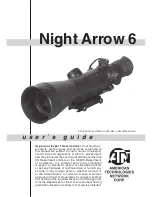
9
field of view faster at higher magnifications. This is because
the field of view becomes narrower.
Daytime Terrestrial Viewing
Some telescopes can be used for daytime terrestrial observa-
tion in addition to nighttime stargazing. Of the two TableTop
telescopes covered in this manual, only the StarMax 90
Mak-Cass is suitable for terrestrial viewing. With the supplied
accessories, the images you see are right-side-up, but mirror
reversed. Obviously, this is not ideal. For a correctly oriented
image, you can purchase a 1.25" “correct-image” or “image
erecting” diagonal and substitute it for the “star diagonal” that
came with the telescope. Then you will see a normally ori-
ented image, just like you see with your eyes.
Also note that the StarMax 90 optical tube can be removed
from the TableTop base and mounted on a standard photo tri-
pod, if desired. The telescope’s dovetail mounting bar has two
¼”-20 threaded holes on the bottom. Most tripod pan heads
or ball head quick-release plates have a ¼”-20 threaded post,
which would allow coupling of the StarMax 90 optical tube to
the tripod.
The SkyScanner 100 Reflector, like any other reflector type
telescope, is not recommended for terrestrial viewing. That’s
because the image it renders is rotated or upside down and
not easily corrected. This is not an issue for astronomical
viewing because there is no “right side up” in space!
Using the Orion Moon Filter and MoonMap 260
Moon Filter
This popular accessory reduces glare from the bright lunar
surface for more comfortable viewing. It also boosts contrast
so you can enjoy more-detailed views of surface features. The
neutral density filter transmits only 13% of incoming light to
the eyepiece, preventing the overpowering brightness from
washing out details, providing better clarity and resolution,
and reducing eye strain. It does not alter the natural color of
the Moon, either. Just screw the filter into the threaded barrel
of the eyepiece and you’re all set (
Figure 13
).
MoonMap 260
With locations and names of over 260 features on the Moon
such as craters, mountains, valleys, "seas" and more, the
Orion MoonMap 260 is a great tool for beginning astronomers.
This detailed map will even show you where various space-
craft have landed on the Moon's surface! The whole family
will enjoy looking at the Moon with the telescope, then using
the MoonMap 260 to learn the names of the craters and other
features observed. Using a red flashlight (sold separately) to
read the MoonMap in the dark will be helpful; the red light will
not spoil your eyes’ dark adaptation.
What to Expect
So what will you see with your telescope? You should be
able to see bands on Jupiter, the rings of Saturn, craters
on the Moon, the waxing and waning of Venus, and many
bright deep-sky objects. Do not expect to see color as you
do in Hubble Space Telescope photos, since those are taken
with long-exposure cameras and have “false color” added.
Our eyes are not sensitive enough to see color in deep-sky
objects. But remember that you are seeing these objects
using your own telescope with your own eyes, in real time.
And that’s pretty cool!
V. Objects to Observe
Now that you are all set up and ready to go, one critical deci-
sion must be made: what to look at?
A. The Moon
With its rocky surface, the Moon is one of the easiest and
most interesting targets to view with your telescope. Lunar
craters, maria, and even mountain ranges can all be clearly
seen from a distance of 238,000 miles away! With its ever-
changing phases, you’ll get a new view of the Moon every
night. The best time to observe our one and only natural satel-
lite is during a partial phase, that is, when the Moon is NOT
full. During partial phases, shadows are cast on the surface,
which reveal more detail, especially right along the border
between the dark and light portions of the disk (called the
“terminator”). A full Moon is too bright and devoid of surface
Figure 13.
The Moon filter threads into the eyepiece barrel as
shown.
Moon filter
Figure 12.
Megrez connects the Big Dipper’s “handle” to its “pan.”
If you cannot see Megrez, a magnitude 3.4 star, then the viewing
conditions are poor.






















